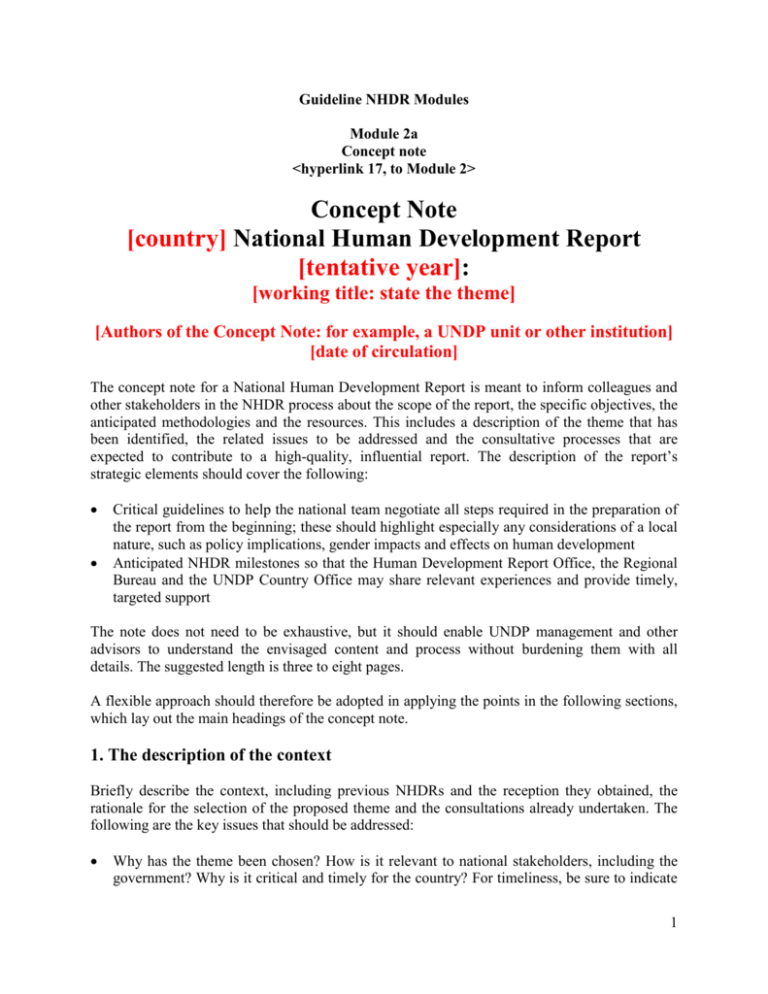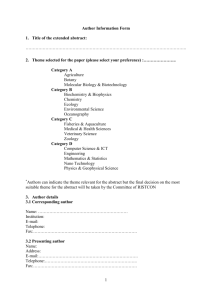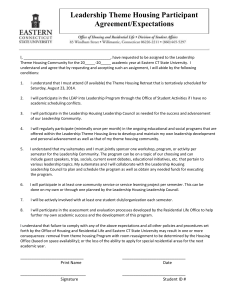Concept Note Template - Human Development Reports
advertisement

Guideline NHDR Modules Module 2a Concept note <hyperlink 17, to Module 2> Concept Note [country] National Human Development Report [tentative year]: [working title: state the theme] [Authors of the Concept Note: for example, a UNDP unit or other institution] [date of circulation] The concept note for a National Human Development Report is meant to inform colleagues and other stakeholders in the NHDR process about the scope of the report, the specific objectives, the anticipated methodologies and the resources. This includes a description of the theme that has been identified, the related issues to be addressed and the consultative processes that are expected to contribute to a high-quality, influential report. The description of the report’s strategic elements should cover the following: Critical guidelines to help the national team negotiate all steps required in the preparation of the report from the beginning; these should highlight especially any considerations of a local nature, such as policy implications, gender impacts and effects on human development Anticipated NHDR milestones so that the Human Development Report Office, the Regional Bureau and the UNDP Country Office may share relevant experiences and provide timely, targeted support The note does not need to be exhaustive, but it should enable UNDP management and other advisors to understand the envisaged content and process without burdening them with all details. The suggested length is three to eight pages. A flexible approach should therefore be adopted in applying the points in the following sections, which lay out the main headings of the concept note. 1. The description of the context Briefly describe the context, including previous NHDRs and the reception they obtained, the rationale for the selection of the proposed theme and the consultations already undertaken. The following are the key issues that should be addressed: Why has the theme been chosen? How is it relevant to national stakeholders, including the government? Why is it critical and timely for the country? For timeliness, be sure to indicate 1 that the length of the report preparation process has been taken into consideration. Who is the target audience? Be specific in identifying the public institutions, policy makers, vulnerable groups, civil society organizations and international stakeholders that would benefit from advocacy on the issues to be raised in the report. What is the report trying to achieve? Identify key objectives in terms of the potential to use the report to advocate for specific policy changes, to have an impact on specific initiatives, or to influence the public discourse in critical areas. 2. The review of experience Present the results of an initial review of the existing literature and other evidence on the selected theme and major related issues. The focus should be on providing colleagues and other stakeholders with the means to understand that the report will find a significant niche and be able to add substantial value to the public discourse on the theme and the search for solutions to the related problems. This review should highlight the following: Definitions of the main concepts relevant to the theme and the issues and descriptions of policy implications Relevant gender analyses that are associated with the theme Discussions of the theme and issues in monitoring documents on the Millennium Development Goals Analytical approaches that have been applied to the theme and issues Analyses of the human development implications involved in the theme and issues; this should include any analyses in global HDRs or regional and national HDRs Thematic reference materials for http://hdr.undp.org/en/nhdr/support/thematic/. NHDRs are available at 3. The logical framework The concept note should explain the value that may be added by the NHDR. The focus should be on the following: The value of an in-depth analysis of the human development issues associated with the theme; thus, an NHDR on water might demonstrate the quantitative and qualitative value of improvements in water storage and distribution infrastructure to people’s welfare and livelihoods The main assumptions and key considerations that form the logical framework of the proposed analysis of the theme and issues The critical dimensions of an exploration of the theme and issues; thus, an NHDR on youth might highlight how addressing the related issues could affect youth unemployment or the system of juvenile justice The need for the collection of new evidence and other information on the theme; thus, the national report team might commit to plumbing national and international data sources, including qualitative sources such as focus groups, to gather meaningful data on the theme 2 and help in analysing the local situation The need to measure human development indicators to gauge development inequalities within the country, including geographical inequalities and inequalities across social groups See the HDR Toolkit for HDR Teams http://hdr.undp.org/en/humandev/learnmore/title,1281,en.html) and the publication Measuring Human Development: a Primer (http://hdr.undp.org/en/nhdr/support/primer/) for additional guidelines and examples. 4. The process Describe the process planned for the preparation of the report. This should include the following: An outline of the management structure responsible for the NHDR process; usually, this involves a major role for UNDP and extensive consultation and coordination with the government A description of the composition of the national report team, for example, the research institute or team of academics and experts consulting on the report, the team leader responsible for the final editing of the report and the statistics experts who will ensure the proper calculation of the main indicators A description of the consultations to be undertaken during report preparation, including with national and local institutions, civil society, expert groups, policy makers and parliamentarians, the national statistics office, local communities and their leaders, international organizations, and so on; be precise in the identification of stakeholders based on their concrete interest in the theme A description of the planned peer review process, which should involve the advisory committee, national and international peer reviewers and so on A description of the outreach strategy, including how advocacy and outreach events, media events, public debates and so on will be used throughout NHDR preparation, to support the launch of the report and as part of the follow-up effort See the HDR Timeline (http://hdr.undp.org/external/timeline/timeline.htm) for additional details about the HDR process. 5. Working outline Describe the main areas covered in the report and a tentative structure, which might be organized by chapter, topic, issues, or otherwise, as appropriate. Annex Include any relevant additional information—for example, proposed statistical tables, terminology, charts, references to other publications, and so on—that might help colleagues and advisors grasp the analytical framework. 3








